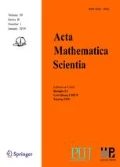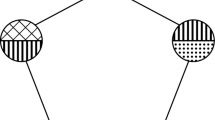Abstract
The asymptotic normality of the fixed number of the maximum likelihood estimators (MLEs) in the directed finite weighted network models with an increasing bi-degree sequence has been established recently. In this article, we further derive the central limit theorem for linear combinations of all the MLEs with an increasing dimension when the edges take finite discrete weight. Simulation studies are provided to illustrate the asymptotic results.
Similar content being viewed by others
References
Agneessens F, Roose H, Waege H. Choices of theatre events: p* models for affiliation networks with attributes. Metodoloski Zvezki, 2004, 1: 419–439
Battiston S, Catanzaro M. Statistical properties of corporate board and director networks. The European Physical Journal B-Condensed Matter and Complex Systems, 2004, 38(2): 345–352
Bickel P J, Chen A, Levina E, et al. The method of moments and degree distributions for network models. The Annals of Statistics, 2011, 39(5): 2280–2301
Billingsley P. Convergence of probability measures. John Wiley & Sons, 1968
Blitzstein J, Diaconis P. A sequential importance sampling algorithm for generating random graphs with prescribed degrees. Internet Mathematics, 2011, 6(4): 489–522
Britton T, Deijfen M, Martin-Löf A. Generating simple random graphs with prescribed degree distribution. Journal of Statistical Physics, 2006, 124(6): 1377–1397
Chatterjee S, Diaconis P, Sly A. Random graphs with a given degree sequence. The Annals of Applied Probability, 2011, 21(4): 1400–1435
Darmois G. Sur les lois de probabilitéa estimation exhaustive. CR Acad Sci Paris, 1935, 260(1265): 85
Ergün G. Human sexual contact network as a bipartite graph. Physica A: Statistical Mechanics and its Applications, 2002, 308(1): 483–488
Fienberg S E. A brief history of statistical models for network analysis and open challenges. Journal of Computational and Graphical Statistics, 2012, 21(4): 825–839
Freeman L C, Webster C M, Kirke D M. Exploring social structure using dynamic three-dimensional color images. Social Networks, 1998, 20(2): 109–118
Freeman S, Freeman L. The networkers network: A study of the impact of a new communications medium on sociometric structure//Social Science Research Reports 46. Irvine, CA: University of California, 1979
Hillar C, Wibisono A. Maximum entropy distributions on graphs. arXiv:1301.3321, 2013
Holland P W, Leinhardt S. An exponential family of probability distributions for directed graphs. Journal of the American Statistical Association, 1981, 76(373): 33–50
Koopman B O. On distributions admitting a sufficient statistic. Transactions of the American Mathematical Society, 1936, 39(3): 399–409
Luo J, Qin H, Yan T, Zeyneb L. A note on asymptotic distributions in directed exponential random graph models with bi-degree sequences. Communications in Statistics-Theory and Methods, 2017, 46(18): 8852–8864
Newman M E. Scientific collaboration networks. I. network construction and fundamental results. Physical Review E, 2001, 64(1): 016131
Pitman E J G. Sufficient statistics and intrinsic accuracy//Mathematical Proceedings of the Cambridge Philosophical society. Cambridge Univ Press, 1936, 32: 567–579
Rinaldo A, Petrovic S, Fienberg S E. Maximum lilkelihood estimation in the beta-model. The Annals of Statistics, 2013, 41(3): 1085–1110
Skvoretz J, Faust K. Logit models for affiliation networks. Sociological Methodology, 2002, 29(1): 253–280
Snijders T A, Lomi A, Torló V J. A model for the multiplex dynamics of two-mode and one-mode networks, with an application to employment preference, friendship, and advice. Social Networks, 2013, 35(2): 265–276
Wang P, Sharpe K, Robins G L, Pattison P E. Exponential random graph (p*) models for affiliation networks. Social Networks, 2009, 31(1): 12–25
Watts D J, Strogatz S H. Collective dynamics of small-world networks. Nature, 1998, 393(6684): 440–442
Yan T, Leng C, Zhu J. Asymptotics in directed exponential random graph models with an increasing bi-degree sequence. The Annals of Statistics, 2016, 44(1): 31–57
Yan T, Qin H, Wang H. Asymptotics in undirected random graph models parameterized by the strengths of vertices. Statistica Sinica, 2016, 26(1): 273–293
Yan T, Xu J. A central limit theorem in the β-model for undirected random graphs with a diverging number of vertices. Biometrika, 2013, 100(2): 519–524
Yong Z, Chen S, Qin H, Yan T. Directed weighted random graphs with an increasing bi-degree sequence. Statistics and Probability Letters, 2016, 119: 235–240
Zhang H, Liu Y, Li B. Notes on discrete compound poisson model with applications to risk theory. Insurance Mathematics and Economics, 2014, 59: 325–336
Zhao Y, Levina E, Zhu J. Consistency of community detection in networks under degree-corrected stochastic block models. The Annals of Statistics, 2012, 40(4): 2266–2292
Author information
Authors and Affiliations
Corresponding author
Additional information
Luo’s research is partially supported by the Fundamental Research Funds for the Central Universities (South-Central University for Nationalities (CZQ19010)), National Natural Science Foundation of China (11801576), and the Scientific Research Funds of South-Central University For Nationalities (YZZ17007); Qin’s research is partially supported by National Natural Science Foundation of China (11871237); Wang’s research is partially supported by the Fundamental Research Funds for the Central Universities (South-Central University for Nationalities (CZQ18017)).
Electronic supplementary material
Rights and permissions
About this article
Cite this article
Luo, J., Qin, H. & Wang, Z. Asymptotic Distribution in Directed Finite Weighted Random Graphs with an Increasing Bi-Degree Sequence. Acta Math Sci 40, 355–368 (2020). https://doi.org/10.1007/s10473-020-0204-8
Received:
Revised:
Published:
Issue Date:
DOI: https://doi.org/10.1007/s10473-020-0204-8
Key words
- Central limit theorem
- finite discrete network
- increasing number of parameters
- maximum likelihood estimator




